Hi!
I am not sure which forum analog-to-digital converters belong to, so here comes my question:
I have built an instrumentation amplifier using the INA849 chip.
Now I need to digitize the output signal and get it into my Ubuntu Linux PC (via a USB port), in a way where I can record the signal and save it to a standard file-format for later analyzing.
I can probably use the Audacity software for the recording and saving, if the device has a Linux driver.
I can see a large amount of ADCs here: https://www.ti.com/data-converters/adc-circuit/products.html
But I am not sure how to find what I am looking for.
Note: I need at least 2 channels and at least 16 bit samples.
To begin with I need to sample the audio spectrum (approximately 0-20.000 Hz), but it would be nice if the board/device can go much higher, maybe 100 KHz or 400 KHz, and it would be very nice if there is some kind of frequency-adjustable, effective low-pass filter before the digitalization.
I look forward to hear from you.
Thank you.






